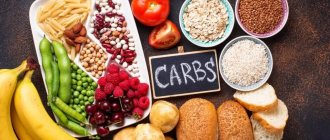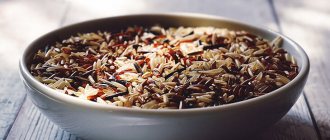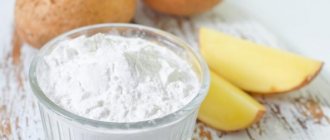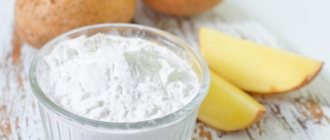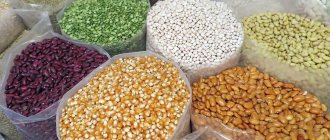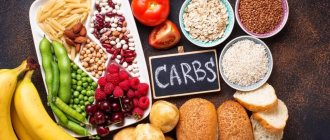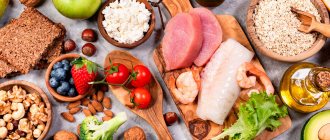What are complex carbohydrates and why are they healthy?
Complex carbohydrates are polysaccharides with a long molecular chain. It so happens in nature that complex carbohydrates are the key source of energy. This type of polysaccharides includes starch, glycogen, dietary fiber, pectin and a number of other substances, without which normal biochemical processes are impossible.
Complex carbohydrates contain different structural elements that take time to digest. One of these elements is fiber, which is not digested in the stomach. Water-soluble and water-insoluble plant fibers are important for further absorption. In contrast, simple polysaccharides are digested very quickly, without much effort for the body.
The main characteristic that determines the benefits of complex carbohydrates is the glycemic index. For the nutrition of a healthy person and especially a person with diabetes, it is important that the calories contained in food are absorbed gradually. Slow processes of polysaccharide breakdown do not provoke surges in blood glucose. It is recommended for overweight people to consume foods that include complex carbohydrates, since obesity is accompanied by a disorder of insulin synthesis.
A sharp change in blood sugar levels causes a feeling of hunger and stimulates appetite. The introduction of complex carbohydrates into the diet is recommended for people who follow the rules of a healthy lifestyle, diabetics and simply anyone who wants to normalize their metabolism and ensure a normal weight.
It has been proven that plant fibers have probiotic properties, i.e. they stimulate the growth and spread of beneficial intestinal microflora. A healthy intestine fully digests food, provides high immune protection, and controls cholesterol in the blood. Fast, simple carbohydrates do not have these properties, but, on the contrary, suppress intestinal function.
Types of complex carbohydrates
The classification of complex carbohydrates depends on the glycemic index. The following types are distinguished:
- Glycogen - includes glucose molecules connected in a special chain. Maintains a stable concentration of sugar in the blood, promotes the restoration of muscle mass. Glycogen is found in animal products (red meat, beef heart, liver), fish.
- Pectin is a sticky substance that is essentially a derivative of galacturonic acid. The peculiar structure does not allow carbohydrates to be absorbed, but gives it adsorbing properties. Pectin perfectly absorbs toxins, putrefactive bacteria, pathogens and completely removes them from the body. These qualities provide protection for the mucous membrane of the gastrointestinal tract from mechanical damage and chemical influences.
- Starch is an insoluble plant fiber that ensures a uniform release of energy and long-term satiety after eating. The complex polysaccharide slows down the rise in glucose and blocks insulin surges, thus protecting the pancreas from destructive stress. Thanks to starch, normal metabolism is maintained and the body's defenses are increased. The best sources of starch are oatmeal, brown rice, lentils, pasta, buckwheat, rye bread, potatoes, legumes (soybeans, peas, lentils).
- Fiber is a plant fiber that works like a brush that “cleans out” excess cholesterol. Thanks to fiber, bile flow improves and intestinal function is normalized. The main sources of fiber are berries, seeds and nuts, fruit and vegetable peels, oats, buckwheat, citrus fruits, cabbage, apples, wholemeal flour.
The role of disaccharides in the body
When considering complex and simple carbohydrates, it is worth touching on the role of disaccharides - elements that have a more complex structure, but belong to the second category. They are divided into the following types:
- Maltose is an intermediate element between starch and glycogen. After entering the body, it is converted into glucose. Moreover, its increased volume is found in beer, malt extract and honey.
- Lactose is the main component of dairy products. After entering the body, it is converted into glucose and galactose. People often experience intolerance to this substance.
- Sucrose is considered the most harmful . Its peculiarity is the lack of nutrients. After entering the body, it is broken down, and the resulting elements are sent to create fat. Unhealthy foods high in sucrose include jam, sweet drinks, and others.
Unlike monosaccharides, disaccharides are not as sweet and less soluble. The main suppliers are the following products: vegetables, fruits, melons, cane juice. It is worth noting that the disaccharide from beet or cane juice is converted into a monosaccharide after entering the body. As for the functional purpose, it is identical to glucose.
Are all complex carbohydrates digested slowly?
When switching to a diet that predominantly contains complex carbohydrates, it is important to understand that not all of them are equally beneficial. If we talk about starch, then in wheat and white rice it has an equally complex molecular structure, but is unable to quickly digest and absorb in the gastrointestinal tract.
Many carbohydrate foods contain maltodextrin, a complex polysaccharide consisting of long molecular chains. Despite its complex structure, it acts in the gastrointestinal tract like a regular carbohydrate and is quickly absorbed.
The most complex products are pasta made from wheat. The rate of absorption is affected by the type of wheat, the method of preparation, and the portion that a person uses as a side dish. Depending on these parameters, pasta has a high, medium or low glycemic index. When high, they have the properties of simple (fast) carbohydrates, and when low, they have the properties of carbohydrates with complex (long-term) absorption.
The complexity of a carbohydrate depends on its fiber concentration. If a food product contains a lot of plant fiber, it is said to be beneficial. For example, potatoes, which are classified as carbohydrate foods, have very little fiber, but a lot of starch. Knowing this feature, you should correctly calculate the optimal portion. Beans are a healthier carbohydrate product - per 100 g of dry beans there are 60 g of complex polysaccharides, 1/4 of which is fiber.
Table of carbohydrate content in food
| Name | Amount of element per 100 grams of product |
| Legumes | 2-63 gr |
| Cereals and grains | 3-73 gr |
| Fruits and dried fruits | 5-88 g |
| Vegetables | 5-80 gr |
| Milk products | 2-54.5 g |
| Fish and seafood | 1.5-11.5 g |
| Meat | 0.1-5 g |
You don't need to know everything about carbohydrates to get the most out of an element.
It is enough to understand the individual characteristics of your body, be aware of its needs, navigate the composition of food products and eat a balanced diet.
Which foods contain the most complex carbohydrates?
The classification of carbohydrates into simple and complex, based solely on differences in structure, is not entirely correct. It is more correct to divide polysaccharides according to the glycemic index - the ability of the product to be converted into glucose. The glycemic index (GI) in foods varies from 0 to 100. A high GI indicates rapid absorption of foods, a low GI indicates slow absorption.
The concept of GI was formed when measuring blood sugar levels in the morning after eating a product on an empty stomach.
Based on the data obtained, they distinguish:
- Low GI - less than 55.
- The average GI is 55-69.
- High - more than 70.
It is important to remember that the glycemic index is considered together with the glycemic load. Glycemic load (GL) is calculated based on the carbohydrate content of the product.
GN can be:
- Low - less than 10.
- Average - from 10 to 19.
- High – more than 20.
The optimal combination of these indicators determines the benefits of a high-carbohydrate product.
TOP 10 best foods with the highest content of complex carbohydrates
| Photo | Product: | Kcal: | Carbohydrates (per 100 g) | GI |
| Soybeans | 364 Kcal | 30.2 g | 15 | |
| Black beans | 341 Kcal | 46.9 g | 20 | |
| Lentils | 353 Kcal | 60 g | 25 | |
| Chickpeas | 378 Kcal | 62.9 g | 30 | |
| Wild rice | 357 Kcal | 74.9 g | 35 | |
| Wholemeal bread | 252 Kcal | 42.7 g | 35 | |
| Durum wheat pasta | 352 Kcal | 73.4 g | 40 | |
| Oats | 389 Kcal | 66.1 g | 40 | |
| Buckwheat | 343 Kcal | 70 g | 40 | |
| Green peas (canned) | 81 Kcal | 14.45 g | 48 | |
| Brown rice (unpolished) | 362 Kcal | 76.2 g | 50 |
View the entire table of carbohydrates 350+ ➤
10 more popular foods with long-term absorption:
- Oatmeal - digestion time up to 4 hours, GI - 66.
- Boiled rice - digestible in up to 3 hours, GI - 65.
- Boiled potatoes - digestion takes from 2 to 3 hours, depending on the variety, GI - 65.
- Beets - digestible in 3 hours, GI - 65.
- Raisins - digestible within 2 hours, GI - 65.
- Rye bread - digestion from 3 to 3.5 hours, GI - 65.
- Pearl barley - digestible within 1.5 hours, GI - 22.
- Bananas - digested in 1 hour, GI - 60.
- Cabbage - digestible in up to 4 hours, GI - 10.
- Processed cheese - digestion for 3 hours, GI - 56.
[Video] Best sources of complex carbohydrates:
Vegetables are record holders
| Photo | Product: | Kcal: | Carbohydrates (per 100 g) | GI |
| Broccoli | 34 Kcal | 6.6 g | 10 | |
| Cabbage | 28 Kcal | 6 g | 15 | |
| Artichoke | 53 Kcal | 12 g | 20 | |
| Beet | 40 Kcal | 11.3 g | 54 | |
| Potatoes (boiled) | 77 Kcal | 19.6 g | 65 |
It should be noted that if potatoes are fried or mashed, the GI will jump to 95. In addition, the calorie content will increase: fried - 184 KCal, fried - 266 KCal, chips - 538 KCal, mashed potatoes - 92 KCal.
Fruits and berries are record holders
| Photo | Product: | Kcal: | Carbohydrates (per 100 g) | GI |
| Grapefruit | 33 Kcal | 8.4 g | 22 | |
| Prunes | 256 Kcal | 63.9 g | 25 | |
| Dried apricots | 241 Kcal | 62.6 g | 30 | |
| Grape | 64 kcal | 16 g | 40 | |
| Persimmon | 67 Kcal | 16.9 g | 55 | |
| Banana | 89 kcal | 22.8 g | 60 |
And now the results
To ensure that the effectiveness of your training is always at its best, and that you have a lot of strength and energy for this, it is important to adhere to certain rules:
- The diet should consist of 65-70% carbohydrates, and they should be “correct” with a low glycemic index;
- Before training you need to consume foods with average GI values, after training – with low GI values;
- Breakfast should be as dense as possible, and in the first half of the day you should eat most of the daily dose of carbohydrates;
- When buying products, check the glycemic index table and choose those that have medium and low GI values;
- If you want to eat foods with high GI values (honey, jam, sugar), it is better to do this in the morning;
- Include more cereals in your diet and consume them regularly;
- Remember, carbohydrates are assistants to proteins in the process of building muscle mass, so if there is no tangible result for a long time, then you need to reconsider your diet and the amount of carbohydrates consumed;
- Eat non-sweet fruits and fiber;
- Remember wholemeal bread and baked potatoes in their skins;
- Constantly update your knowledge about health and bodybuilding.
If you adhere to these simple rules, your energy will noticeably increase, and the effectiveness of your training will increase.
Dietary intake of complex carbohydrates for men and women
Calculating the norm of consumption of complex carbohydrates for men and women depends on age, initial weight, daily activity, and most importantly, on the goal.
Norm for women
For women who want to lose weight, the following daily norms of slowly digestible carbohydrates are determined:
- With an initial weight of 50-55 kg - 110 g.
- Weight 60-65 kg - 140 g.
- Weight 70-75 kg - 160 g.
- Initial weight 80-85 kg - 170 g.
To maintain optimal weight, slightly different daily intakes of complex carbohydrates are recommended:
- Weight 50-55 kg - 140 g.
- Weight 60-65 kg - 160 g.
- Weight 70-75 kg - 190 g.
- Weight 80-85 kg - 210 g.
If a woman’s goal is to gain weight, the daily intake of complex carbohydrates should be increased:
- Initial weight 50-55 kg - 190 g.
- Weight 60-65 kg - 240 g.
- Weight 70-75 kg - 250 g.
- Weight 80-85 kg - 260 g.
Norm for men
For men, the daily intake of complex carbohydrates is slightly higher, and they also depend on the goal and initial body weight.
If you want to lose weight, a man is shown the following daily carbohydrate intake:
- Initial weight 50-55 kg - 165 g.
- Weight 60-65 kg - 170 g.
- Weight 70-75 kg - 175 g.
- Weight 80-85 kg - 185 g.
To maintain optimal body weight in men, other daily dosages of complex polysaccharides have been determined:
- Initial weight 50-55 kg - 220 g.
- Weight 60-65 kg - 235 g.
- Weight 70-75 kg - 245 g.
- Weight 80-85 kg - 265 g.
To increase weight, men are recommended to increase the dose of carbohydrates per day:
- Initial weight 50-55 kg - 280 g.
- Weight 60-65 kg - 295 g.
- Weight 70-75 kg - 310 g.
- Weight 80-85 kg - 320 g.
To avoid mistakes, calorie calculations and menu planning taking into account complex carbohydrates should be carried out by a nutritionist based on the initial parameters.
The harm of fructose and corn syrup
Since childhood, we have become accustomed to advertising, with firm confidence driving into the faceted slabs of memory that juices for breakfast or for children as a snack at school are an excellent and healthy alternative to sugar. It would seem that there is nothing wrong with a smoothie or fresh juice - after all, fruits have always been associated with health! To answer this question it is necessary to turn again to biochemistry.
Our cells are not able to use fructose as an energy source, so its metabolism in the liver includes only two ways: conversion into glucose or the formation of triglycerides (fat, in a word).
This monosaccharide plays a key role in the development of non-alcoholic fatty liver disease. Imagine foie gras: the unfortunate animal is force-fed so that its liver becomes overgrown with a sheath of fat, turning into a gourmet restaurant dish. The human one will be little different - except that no one will serve it to you on a white plate.
High daily consumption of this monosaccharide leads to the development of more severe liver damage: non-alcoholic steatohepatitis and cirrhosis.
Study
: Does fructose consumption contribute to non-alcoholic fatty liver disease?
This is why it is so important to pay attention to your waist size—its increase will be the first warning sign.
But the insidiousness of fructose doesn’t end there: it bypasses many satiety signals in our body. It's all about leptin, the satiety hormone that is secreted by adipose tissue. Its release is increased by the action of insulin, the concentration of which in the blood after consuming fructose will be quite low.
Targeted nutrition tips
that will increase your energy level by 10 out of 10
From TOP nutritionists of the MIIN
Get tips
Moreover, fructose, unlike glucose, is not transported into the nervous tissue of the brain - and it does not pick up satiety signals. Thus, the feeling of hunger does not disappear even after eating - a person simply cannot get enough.
Study
: Consumption of high-fructose corn syrup in beverages may play a role in the epidemic of obesity
Excessive consumption of fructose is associated with increased levels of uric acid, a trigger in the development of gout.
Scientists conducted an interesting study with rats that followed a high-fructose diet for ten weeks. They experienced increased blood pressure and triglyceride levels, as well as the development of insulin resistance.
However, in the group that simultaneously took uric acid-lowering drugs (allopurinol and benzbromarone), these indicators were significantly better.
Study
: The Effect of High-Fructose Corn Syrup Consumption on Triglycerides and Uric Acid
A high-fructose diet promotes an overgrowth of gram-negative flora, and lipopolysaccharide, a component of their cell wall, enters the bloodstream. Watchdogs in the form of receptors immediately react to it - oxidative stress is triggered and the transmission of signals from insulin is simultaneously inhibited both in its peripherally located target cells and in the neurons of the hypothalamus - the most important structure of the brain.
It is important to add that such strong agents as free radicals, even if in this case they are formed outside the mitochondria, easily penetrate into the latter, causing transport collapse there in the form of electron leakage.
Study
: Consumption of high-fructose corn syrup in beverages may play a role in the epidemic of obesity
In the 1970s, it accounted for less than one percent of its sales in the American sweetener market. By the 2000s, its share had already reached 42% - an amazing success.
Today it is difficult to find a product in the United States in which manufacturers do not add it: soft drinks, candied fruits, yogurts, baked goods, jellies and even many cereals - it is lost on their labels. All this leads to an increase in the incidence of obesity among children and adolescents - the main consumers of sugary drinks, cereals and desserts.
The fructose content in this syrup varies from 42% to 55%
.
Studies have shown that consuming corn syrup increases glucose (and therefore insulin) levels.
It is recommended to consume about 100-150 grams
carbohydrates per day (provided there are no metabolic disorders).
So, after we eat any food containing carbohydrates and proteins (we will focus on them in other articles), the cells of the pancreas begin to actively secrete insulin.
This is a protein hormone whose main task is to reduce blood glucose levels. Insulin itself does not transport anything: by interacting with its receptors, it only increases the density of specific carriers on the cell surface.
Glucose enters the cell, where various pathways for its utilization are activated:
- Glycolysis
— this process supplies raw materials for power plants, in other words, prepares firewood for mitochondrial furnaces.
Glucose is converted into pyruvate (pyruvic acid), which, in turn, in the absence of oxygen is metabolized into lactic acid - lactate (it is these processes that occur in actively contracting muscles during physical activity).
In aerobic, that is, oxygen, conditions, pyruvate, in the process of biochemical reactions and with the participation of a complex of a large number of enzymes, is converted into acetyl-CoA, which enters the tricarboxylic acid cycle (Krebs cycle).
In fact, all incoming food (proteins, fats, carbohydrates) will ultimately form acetyl-Coa - this is a universal chess piece along the path of complex energy production mechanisms.
- Pentose phosphate pathway
- another way to utilize glucose. And if glycolysis is one of the key stages of energy production, then this mechanism ensures the formation of phosphopentoses - the building blocks for the construction of DNA and RNA.
Also, its second, no less important function is the restoration of the coenzyme form of vitamin B3 (NAD+) to NADH2 - this is necessary for the functioning of glutathione - one of the main protectors of cells, including blood cells, from free radicals. If this process is disrupted, hemolytic anemia is observed - increased breakdown of red blood cells. The released hemoglobin is converted into the bile pigment bilirubin, which is highly toxic to the human body.
- Finally, glucose can go to glycogen synthesis
- this is the substance with which, in addition to fat, the storerooms in our body are filled.
The fact is that storing glucose is quite difficult: it freely leaves the cell, so it is necessary to involve various biochemical reactions to convert it into more fixed forms - this is not economical in terms of energy use.
So nature found a way to preserve it - it mainly happens in the kitchen of the liver and muscles. However, you shouldn’t get your hopes up too much - the volume of stored glycogen is also strictly limited (200-250 grams) - all excess incoming carbohydrates will turn into fat.
Liver glycogen is used to maintain optimal blood glucose levels, while glycogen in muscles is spent on their own needs.
The main causes of carbohydrate metabolism disorders:
- Excessive glucose intake.
- Fructose abuse.
- Excessive intake of foods with a high glycemic index.
- Excessive intake of foods with a high insulin index.
- Insufficient physical activity.
Strategy for correcting carbohydrate metabolism:
- Three meals a day
, no snacks (unless there are medical contraindications).
- Elimination of simple carbohydrates
- insulin will be secreted even when complex sugars are supplied, however, its release and further decline will be more uniform and smooth.
- Breakfast
- protein-fat, quite filling and provides energy for a long time.
After a glass of smoothie or fresh orange juice, the feeling of hunger will begin to torment you, wriggling like a worm in your stomach, within 40-50 minutes; Our main task is to reduce the number of meals as much as possible, creating hungry intervals.
This is where olives, cod liver, fatty meats and fish come to the rescue - try eating what you usually find on your plates during lunch.
- Exercise stress
- no less effective for adaptation and even (according to some studies) synthesis of new cellular receptors.
- Elimination of stress agents
(increased secretion of cortisol and adrenaline leads to stimulation of gluconeogenesis and worsening insulin resistance).
- 8 hours sleep
(lack of sleep causes inconsistencies in the synthesis of leptin, the satiety hormone).
The use of gadgets is also not recommended 2 hours before bedtime - blue light from the screen reduces the production of melatonin, which has powerful antioxidant effects.
- Recommended Supplements
:
- berberine (500 mg 3 times a day, in courses);
- taurine (1000 mg 2 times a day);
- ginger (500 mg, 3 times a day);
- fenugreek (150 mg 3 times a day);
- bitter melon (500 mg, 3 times a day);
- cinnamon;
- carnosine (500 mg 3 times a day);
- vanadium (1-3 mg per day);
- chromium polynicotinate (300 mg);
- zinc (25-50 mg);
- magnesium (400 mg);
- vitamin D (depending on laboratory parameters);
- alpha lipoic acid (600 mg, 2-3 times daily).
We recommend
“Antioxidants in food: the most faithful defenders of our body” Read more
New strategies for the treatment of carbohydrate metabolism disorders
:
Glucagon-like peptide-1
is a hormone secreted by intestinal cells in response to food intake, plays an important role in maintaining optimal blood sugar levels - all by stimulating the glucose-dependent secretion of insulin and suppressing its main antagonist,
glucagon
.
Its action is also associated with weight loss by reducing appetite and the amount of food consumed, protective effects on the cardiovascular system and pancreatic beta cells that directly produce insulin - all this actively allows its use as a drug for the treatment of diabetes mellitus. type.
Research
: Glucagon-like peptide-1 (GLP1) and the gastrointestinal tract
Moreover Metformin
- a drug that represents the first line of drug treatment for diabetes mellitus, also stimulates an increase in the synthesis of glucagon-like peptide-1.
Research
: Metformin is a possible glucagon-like peptide 1 stimulator
Will complex carbohydrates help you lose weight?
The right selection of complex carbohydrates will help reduce body weight. This is facilitated by the introduction of fruits, vegetables, and whole grains into the daily diet. To get rid of extra pounds, the daily dose of carbohydrates should be from 10 to 15% of the total calorie intake.
The best complex carbohydrates for weight loss, table:
| Cereals | Amaranth, pearl barley, oatmeal, bulgur, millet, unprocessed rice, quinoa, buckwheat, whole grain flour |
| Legumes | Beans, lentils, various types of beans, green peas, chickpeas |
| Nuts, seeds | Sesame, pumpkin, sunflower seeds, flax seeds, poppy seeds, almonds, pine and walnuts, hazelnuts, cashews, pistachios |
| Greenery | Lettuce, spinach, lettuce |
| Vegetables | Carrots, tomatoes, beets, eggplants, zucchini, broccoli, onions, bell peppers, zucchini, celery |
| Fruits | Citrus fruits, apples, pears, peaches, avocado, pomegranate, figs |
| Berries | Raspberries, cherries, strawberries, currants, plums, cranberries, prunes, sweet cherries, gooseberries |
[Video] How to eat carbohydrates and lose weight:
Laboratory diagnostics of carbohydrate metabolism
Previously, before the advent of modern research methods, doctors were faced with a not particularly noble job: they had to taste urine - and in diabetics it was sweet. Now the task has become somewhat simpler - so, what laboratory indicators are worth paying attention to:
- Triglycerides > 1.7 mmol/l.
An increase in the level of insulin in the blood stimulates lipogenesis - this, by the way, plays an important role in the pathogenesis of acne development: the higher the level of triglycerides, the more sebum is secreted.
- Fasting insulin >5-6 mmol/l.
- NOMA index > 1.3.
- Fasting glucose >5.5 mmol/l.
Optimum: 3.5-5.5 mmol/l.
- Glucose on oral glucose tolerance test >11 mmol/L.
Optimum: <6.9 mmol/L (6.9-11 mmol/L indicates prediabetes).
- Glycated hemoglobin - reflects the average blood sugar content over 3-4 months (lifespan of red blood cells) > 6.5%.
Optimum: up to 5.2%.
- C-peptide is a molecule that is cleaved by protein enzymes from the precursor of insulin and is thus an indicator of its secretion.
Reference: 1.4-4.4 ng/l.
Optimum: middle of reference values.
- LDL (low-density lipoprotein, atherogenic) > 3 mmol/l.
- HDL (high density lipoprotein, antiatherogenic) < 1 mmol/l in men and < 1.2 mmol/l in women.
Glycemic index
(GI) is an indicator of exactly how the carbohydrates consumed affect changes in glucose levels.
As previously mentioned, a feature of simple sugars is their ability to sharply increase the glucose level in the serum - this effect does not distinguish them favorably from complex carbohydrates.
We recommend
“Complex carbohydrates for weight loss, muscle gain and diabetics” Read more
The body's reaction is immediate: a powerful release of insulin occurs in the pancreas - a hormone designed in this case to neutralize excess glucose in the blood, but then follows the same uneven sharp decline. Hence the need to focus on foods with a low glycemic index that do not cause such “swings” in glucose concentrations:
- Chickpeas
- Beans
- Plums
- Pomegranate
- Cherry
- Raspberries
- Currant
- Mushrooms
- Broccoli
- Asparagus
- Fennel
- Lentils
- Avocado
- Olives
- Seaweed
- Cauliflower
- cucumbers
- Leafy vegetables
However, another indicator is no less important - the insulin index.
. It displays the amount of insulin secreted in response to the intake of a specific food.
Very often, foods with a low glycemic index, while having a high insulin index, cause many adverse effects. Such foods include dairy products.
Amino acids with branched side chains contained in milk are powerful stimulators of the synthesis and subsequent release of insulin (the AI of cottage cheese is approximately 100-120). This is a paradoxical situation at first glance: cottage cheese does not cause a sharp jump in glucose (GI = 30 and is quite low), but it leads to a significant secretion of insulin, to the calls of which the cells are already deaf.
The pancreas compensatory begins to produce more and more insulin in order to somehow break through the insurmountable wall - this eventually leads to its depletion. The patient is forced to receive it from the outside - in the form of injections.
Complex carbohydrates for muscle gain
Carbohydrates do not easily provide a person with energy; they prevent the destruction of muscle tissue. With a deficiency of polysaccharides, the body begins to break down muscle fiber cells to obtain the required amount of energy. Products containing carbohydrates should become an obligatory part of the diet of athletes and people of heavy physical labor. Thanks to them, the body compensates for the loss of spent glycogen.
A lack of carbohydrates in food is manifested by fatigue, a decrease in strength indicators, which means that there can be no talk of any muscle relief or body sculpture. Carbohydrates combined with sufficient protein create healthy muscles.
To get the desired muscle volume, you should correctly calculate the amount of carbohydrates. To achieve maximum effect, their volume should be more than 30% of all calories entering the body.
You can supply yourself with healthy carbohydrates using certain foods:
- Brown Uncooked Rice - Combines the right carbohydrates with other nutrients, helps build muscle mass, promotes satiety, and maintains normal blood sugar levels. White, polished rice does not have similar properties.
- Oats provide the body not only with complex carbohydrates, but also with protein, guarantee an increase in muscle fibers, activate digestion, alleviate the symptoms of inflammation, and nourish healthy intestinal microflora.
- Sweet potatoes are a source of vitamins, microelements, fiber, and natural sugars. Useful for nourishing the brain, strengthening the immune system and providing energy.
More details:
Diet for gaining muscle mass for men
Balanced diet
A well-designed diet is suitable as a diet for weight loss, nutrition before and after workouts, and a daily healthy habit. To ensure that your diet benefits your body, follow several important rules:
- Be careful when consuming microelements. Try not to exceed the limits recommended by your doctor.
- Drink the optimal amount of clean still water daily (1.5-2 liters for an adult).
- Eliminate low-quality foods from your diet, as well as foods with a lot of sugar, canned food, soda, fast food and snacks.
- The optimal dietary regimen is considered to be a fractional nutrition system, when meals are divided into 5-6 times and accompanied by small portions.
- Develop good habits. This could be regular exercise, long sleep or morning exercises. They increase the concentration of the hormone serotonin, which has a positive effect on health.
Thanks to vitamins and minerals, the human body is able to function fully. If you feel that you are lacking micronutrients in the food you eat, you can get them through dietary supplements, which come in a variety of forms and flavors. Before changing your diet, it is recommended to visit a doctor and get tested.
What does carbohydrate deficiency lead to?
You won't be able to stock up on complex carbohydrates for future use. Physical activity and intellectual work contribute to the absorption of polysaccharides. To maintain normal functions, the body needs a sufficient amount of carbohydrate foods.
Complex carbohydrates should make up the bulk of your daily diet. Their optimal daily volume for a healthy person should be from 55 to 75% of the total amount of food. No more than 10% of this amount should be simple (fast) carbohydrates. To maintain normal weight, the daily diet of an adult requires the presence of 20-25 g of fiber.
In case of a lack of carbohydrates, the body launches compensation mechanisms. To obtain the necessary energy, one begins to consume one's own proteins and fats, rather than those coming from outside. Protein breakdown provokes the destruction of muscle fibers and a slowdown in metabolism. Consumption of fat to provide energy to the body leads to the formation of ketone bodies and subsequent intoxication. A person feels a deficiency of carbohydrates physically, as constant fatigue, drowsiness, while absent-mindedness and impaired concentration appear.
Complex carbohydrates provide healthy energy. A healthy diet should include foods rich in plant fiber (cereals, vegetables, whole grain bread, fruits).
Description and functions of carbohydrates
Carbohydrates
is a broad class of organic compounds that perform a huge number of functions. These are integral structural components in all tissues of the human body and consist of two chemical elements: carbon and water.
This is the main source of energy - and therefore the life of our cells. Their content varies significantly depending on the functions performed by the organ - for example, the concentration of glucose in the nervous tissue of the brain reaches 0.5 grams/kg.
- Energy
― this is the main source of energy necessary for the normal maintenance of all physiological processes and functions in the body. This is a substrate that, undergoing a series of biochemical processes, will ultimately be sent as firewood to the furnace of mitochondria. In this, of course, the most important role goes to glucose - it is the main actress of the metabolic performance unfolding on stage.
- Structural
- carbohydrates are part of various components of cells, in particular: nucleic acids (DNA and RNA), which ensure the storage and transmission of hereditary information; glycolipids and glycoproteins located in all tissues and organs of the human body - including the brain and spinal cord.
- Protective
― mucus and joint fluid, of which they are components, protect cell surfaces from various types of damage.
In combination with proteins, they form antibodies, interferons, complement components - in other words, they actively participate in immune defense reactions.
Plasma albumins and globulins, blood clotting factors - all these substances also contain carbohydrate molecules.
- Signal function
- are part of various cellular receptors and ligands.
Remember your high school biology lessons: long carbohydrate chains, called glycocalyx, are anchored into cell membranes. This is somewhat reminiscent of the branched tentacles of an octopus, which extend in all directions, providing intercellular interaction and selectivity in relation to chemical substances entering the body.
- Regulate osmotic pressure
- one of the main parameters of homeostasis.
- Storage
- the liver pantry is prudently filled with glycogen jam.
- Detoxification
- glucuronic acid neutralizes toxic indirect bilirubin by binding to it; as well as various rotting products.
- Included in coenzymes
and other biologically active substances (for example, ATP).
- Carbohydrates can form lipids
,
amino acids
and other compounds.
